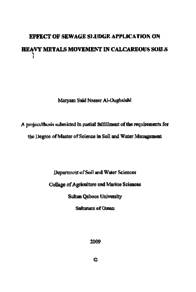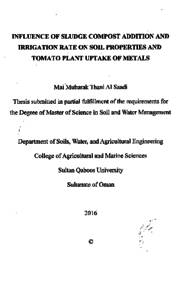Document
Effect of sewage sludge application on heavy metals movement in calcareous soils.
Publisher
Sultan Qaboos University
Gregorian
2009
Language
English
English abstract
Usage of sewage sludge for agricultural purposes is a common practice in many countries around
the world. It contains different nutrients and organic matter which are essential for plants. Besides, it contains different concentrations of heavy metals such as Cd, Cr, Mn, Pb and Zn. These heavy metals are essential for plants in trace amount and some are toxic even in small concentrations. Once these elements present in the soil, it would be difficult to get ride of them. Because they tend to accumulate on the soil surface or percolate to deeper soil layers causinganother problem which is ground water pollution The objectives of this study were to study the distribution of heavy metals (Cd, Fe, Mn, Pb, Zn and Ca and Mg) in sludge treated soil fraction, to detect the dominant element in sludge treated soil fraction, to compare heavy metals in the control and sludge treated soil samples and to assess heavy metals SCS concentration in the top and bottom soil layers. Open ended columns were filled with sandy loam soil to CON ins 45 cm high. Then 260 g of sewage sludge was added to three columns and another three columns were left as control. Distilled water was applied to the columns at a rate of 130 ml three days a week.Then after six months, soil samples were collected and analyzed by sequential extraction procedures and total extraction method. The results of this study showed that after sludge application, the concentration of Mn, Fe and Zn (in both layers) and Cd and Pb (in the top layer), were found in the residual fraction as dominant form. Cadmium and Pb in the bottom layer were found in carbonate fraction. Other elements such as Ca and Mg were not affected by sludge application they were in carbonate and exchangeable fraction, respectively, for both layers before and after sludge application. Thus, elements such as Ca and Mg were in available form to plants before and after sludge application while other elements such as Cd, Mn, Zn and Fe were not in available form because they were strongly bounded to the soil components. Lead on the other hand, tended to percolate to deeper layer of the soil because its concentration in the bottom layer was higher than in the top layer. Thu lead leached out from the soil to deeper layer with water application.
Member of
Resource URL
Arabic abstract
أصبح استخدام الحمأة في مجال الزراعة عوضا عن السماد الحيواني من أكثر النشاطات شيوعا في جميع أنحاء العا وذلك لما تحتويه هذه المادة من مواد غذائية وعناصر حيوية وأملاح معدنية مهمة لنمو النباتات. بعض هذه العناصر يحتاجها النباد بنسب كبيره مثل الكالسيوم والصوديوم والماغنيسيوم وبعضها يحتاج إليها بنسب بسيطة جدا مثل العناصر الثقيلة (الكادميوم، الزنك الحديد). ومن خصائص هذه العناصر العناصر الثقيلة. انها تميل إلى الترسب على سطح التربة وبعضها يتغلغل إلى طبقات الأرض السفلية مما يؤدي إلى إحداث الكثير من التلوث مثل تلوث المياه الجوفية وتلوث التربة بسبب الملوحة الهدف من هذه الدراسة هو دراسة توزيع العناصر الثقيلة (الكادميوم، المنجنيز، الحديد، الزنك والنحاس بالإضافة إلى الكالسيوم والماغنيسيوم) في الأشكال الكيميائية المختلفة التي توجد بها في التربة ومقارنة تركيز هذه العناصر في العينات المعالج بالحمأة والغير معالجة ومقارنة تركيزها في الطبقة العلوية للتربة والطبقة السفلية.
تم أخذ عينات ترية من الحقل ووضعها في أنابيب خاصة مفتوحة من الجانبين وبعد ذلك تم إضافة الحمأة بمعدل ۲۹۰ جم إلى نصف عدد الأنابيب والنصف الآخر لم يضاف له شي. وتم إضافة الماء المقطر إلى الأنابيب بمعدل ۱۳۰ مل ثلاث مرات في الأسبوع. وبعد ستة أشهر تم أخذ العينات وتحليلها باستخدام طريقة الاستخلاص التسلسلي وطريقة الاستخلاص الكلي وبعد ذلك تم تحليلها باستخدام جهاز ICP. أوضحت النتائج أن بعد إضافة الحماه إلى التربة أن المنجنيز و الحديد و الزنك (في كلتا الطبقتين) والكادميوم والنحاس في الطبقة العلوية) كان على شكل متبقي بينما الكدميوم والنحاس في الطبقة السفلية كانا على شكل كربونات وبالنسبة للكالسيوم فإن على شكل كربونات والماغنيسيوم على شكل تبادلي قبل وبعد إضافة الحمأه. وبذلك فإن الكالسيوم والماغنيسيوم يكونان في شك يتيح للنبات باستخدامهما بشكل مريح بينما العناصر الأخرى يكون من الصعب على النبات الاستفادة منها. ووجد أن النحاس يميل إلى أن يتغلغل إلى طبقات التربة السفلية.
تم أخذ عينات ترية من الحقل ووضعها في أنابيب خاصة مفتوحة من الجانبين وبعد ذلك تم إضافة الحمأة بمعدل ۲۹۰ جم إلى نصف عدد الأنابيب والنصف الآخر لم يضاف له شي. وتم إضافة الماء المقطر إلى الأنابيب بمعدل ۱۳۰ مل ثلاث مرات في الأسبوع. وبعد ستة أشهر تم أخذ العينات وتحليلها باستخدام طريقة الاستخلاص التسلسلي وطريقة الاستخلاص الكلي وبعد ذلك تم تحليلها باستخدام جهاز ICP. أوضحت النتائج أن بعد إضافة الحماه إلى التربة أن المنجنيز و الحديد و الزنك (في كلتا الطبقتين) والكادميوم والنحاس في الطبقة العلوية) كان على شكل متبقي بينما الكدميوم والنحاس في الطبقة السفلية كانا على شكل كربونات وبالنسبة للكالسيوم فإن على شكل كربونات والماغنيسيوم على شكل تبادلي قبل وبعد إضافة الحمأه. وبذلك فإن الكالسيوم والماغنيسيوم يكونان في شك يتيح للنبات باستخدامهما بشكل مريح بينما العناصر الأخرى يكون من الصعب على النبات الاستفادة منها. ووجد أن النحاس يميل إلى أن يتغلغل إلى طبقات التربة السفلية.
Category
Theses and Dissertations


